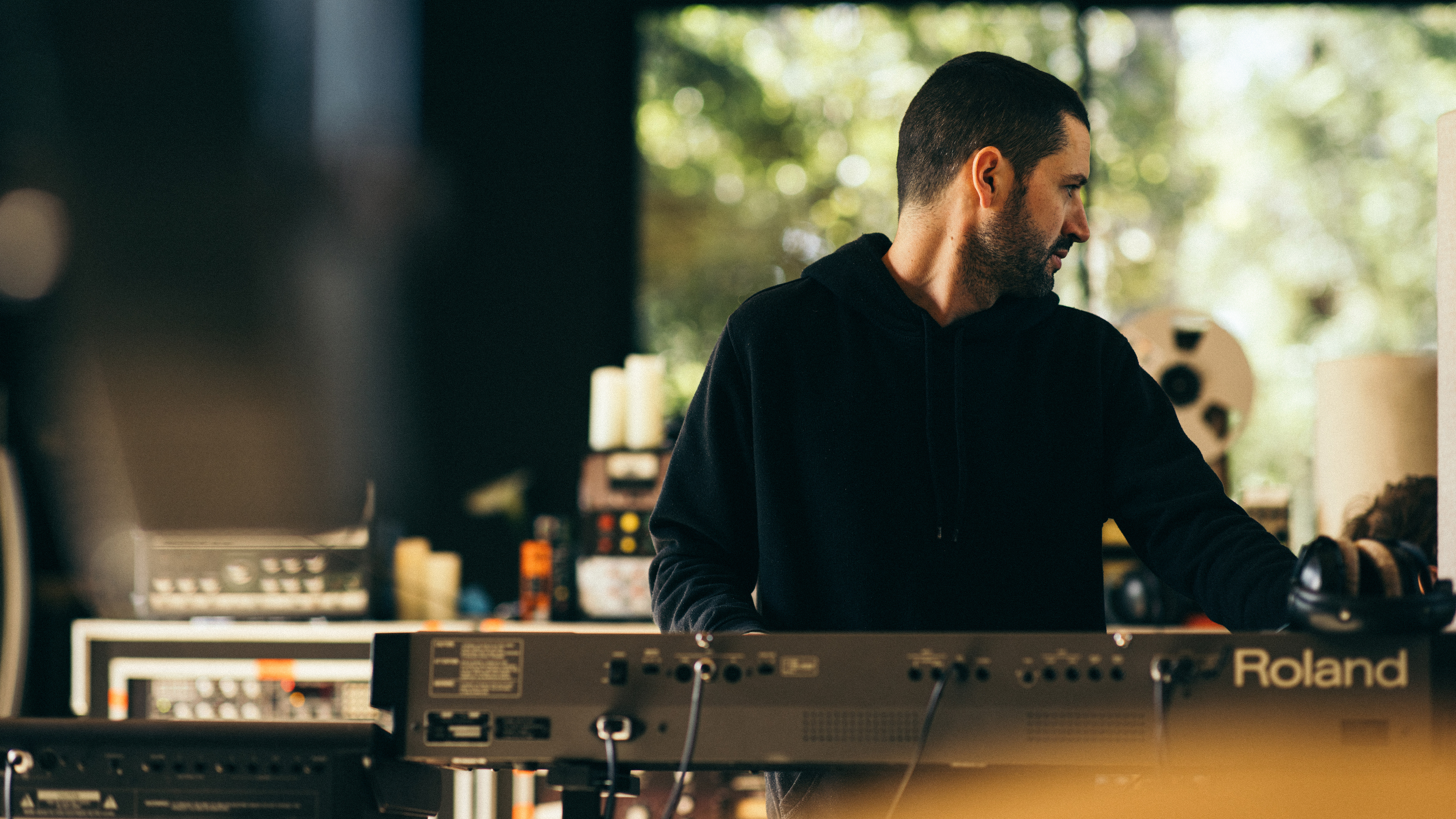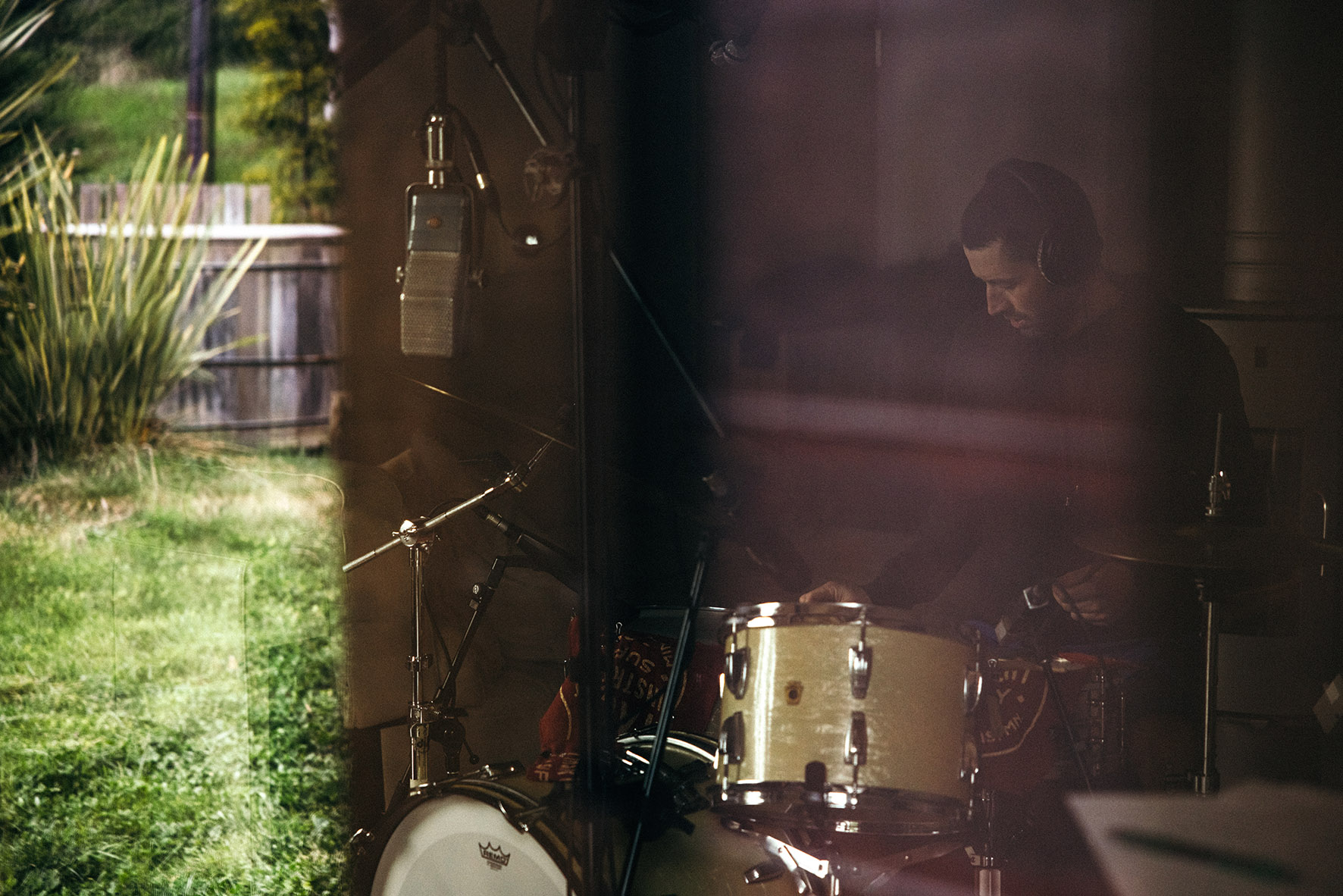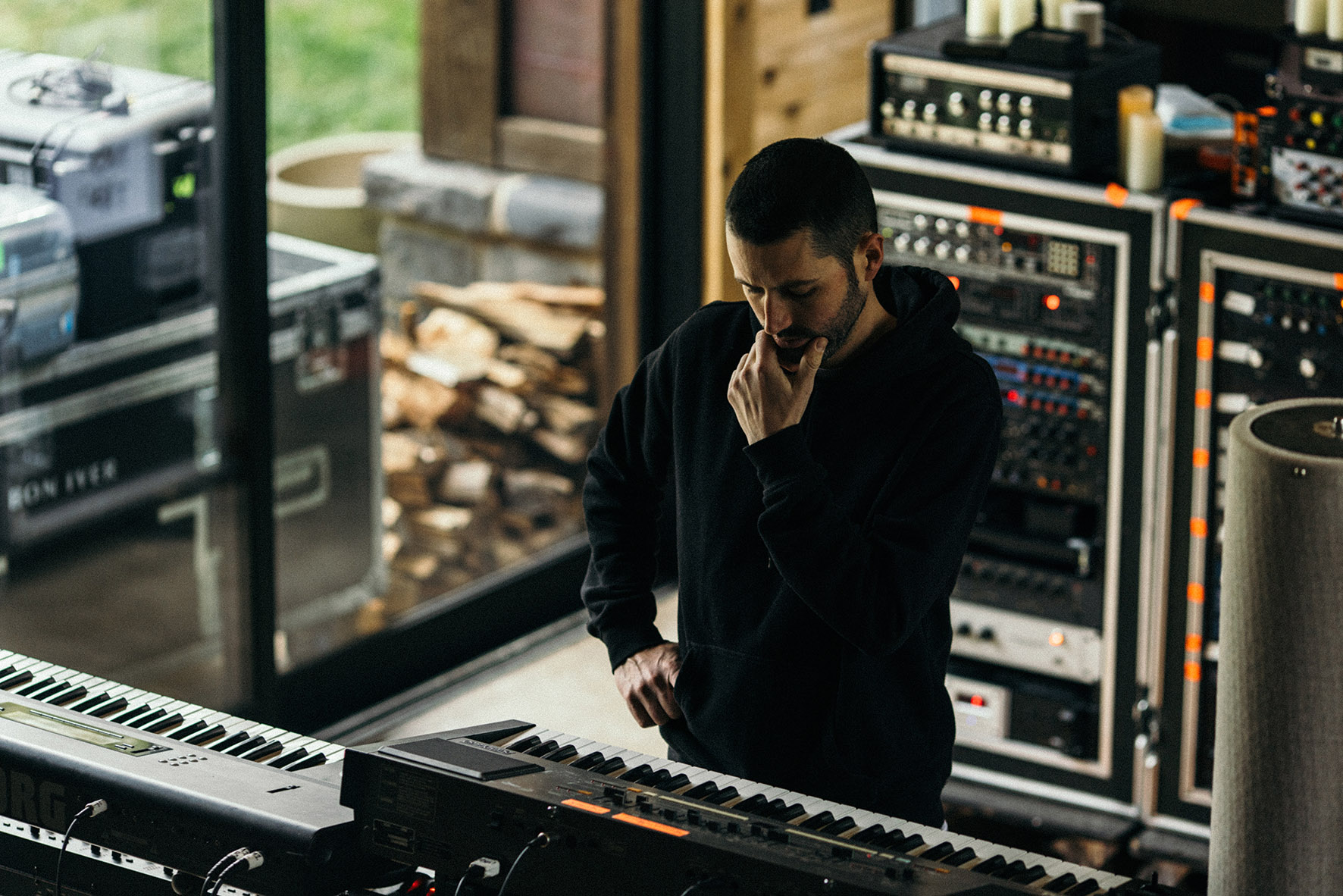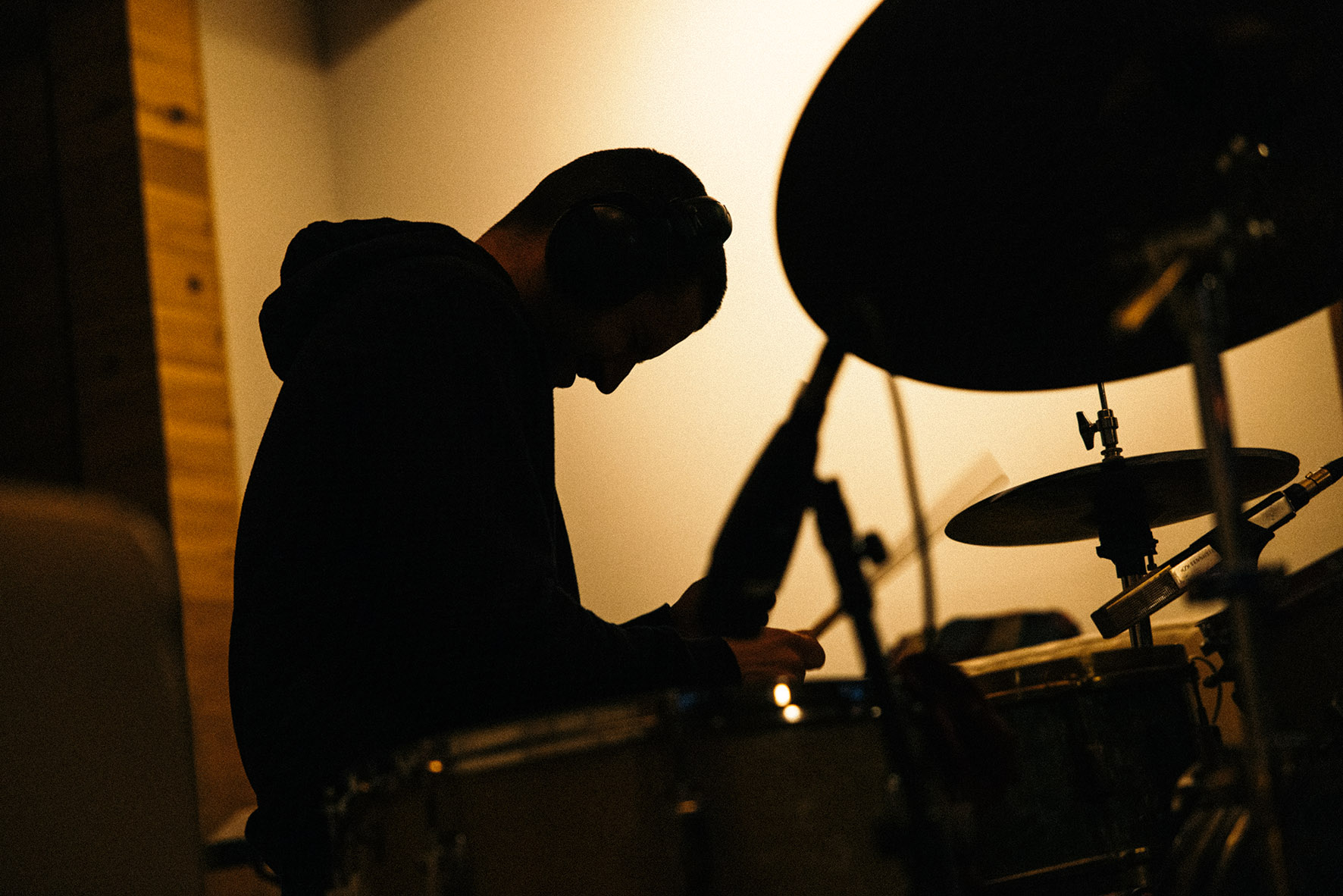S. Carey: "The three of us went out to California and essentially built a studio"
Bon Iver's Sean Carey on heading out west with producers Zach Hanson and Chris Messina to finish his new solo record, Break Me Open

As a central member of Bon Iver’s band, Sean Carey has played no small part in sketching out their baroque indie-folk panoramas, grand vistas of sound and song often framed by a daringly experimental style of production. The music he records as S. Carey, though no less ambitious, operates on a subtler level, concerned more with candid expression than sonic experimentation.
Where Bon Iver’s Justin Vernon roars and hollers in cryptic metaphors, Carey softly articulates touching truths about heartbreak, fatherhood, and solace found in the natural world. Patiently unfurling around whispers of synth and rising strings, the lyrics in the songs that comprise Break Me Open, his new album, show the artist at his most vulnerable. Working alongside producers Chris Messina and Zach Hanson - friends and collaborators, they’re also members of the Bon Iver family - Carey sets his tender confessions against a sublime and stirring instrumental background, lambent constellations glowing in a twilight sky.
Following the record’s release, we spoke with Sean, Chris and Zach to find out more about the songwriting and production process behind Break Me Open.
You guys have worked together for a long time in Bon Iver and other projects. Do you think being friends as well as collaborators brings a new dimension to your creative process?
Sean Carey: “Yeah, for sure. They are always, but especially with these songs, pretty intimate and personal for me. So I needed to work with people that I felt truly comfortable sharing that journey with. It's just kind of a no-brainer with these guys.”
We wanted to get an idea of how the three of you work together and what your collaborative process looked like on this record. Could you go into a little detail on that for us?
Zach Hanson: “It's pretty loose and free for most elements. We're all pretty comfortable behind the keyboard, or if somebody has an idea that they want to try in the session, whoever's at the desk will get up and there's a pretty pretty easy handoff when it comes to things like that, even with performance elements. Generally, if it's vocal-oriented, it's almost always Sean, but Chris can throw down there as well.”
Want all the hottest music and gear news, reviews, deals, features and more, direct to your inbox? Sign up here.
Chris Messina: “Did it even make it on the record, that part?”
ZH: “Yeah, you just kept asking us to turn it down. [laughs]”
SC: “Looking back on our session in California, there was a healthy flow of musical chairs at certain moments where we were just like, ‘Hey, can I sit down and try this?’”
CM: “There was always somebody that could jump in and get something going, whether Sean needed to play something and Zach was in the shower, and I’m there to do the engineering side of it, or vice versa. It’s a rotational thing that happens naturally.
SC: “I feel like it’s become more and more fluid and natural. The more you work together, the more there’s no ego, and no miscommunication.”

In terms of the songwriting process, how long was the album in the works? Which songs did you write first?
SC: “I found a voice memo from 2014 of the song Crestfallen, the initial idea with a synth, and I’m just singing the melody over some terrible patch on a $50 keyboard. That’s about seven or eight years ago. For the tune that Zach and I did together, Sunshower, Zach came up with a lot of the musical elements, the instrumental elements, around that same time period. I always loved that, and could hear vocals on it. I was keeping those demos in the back pocket, thinking I’d turn them into something one day.”
CM: “Even more formally, we were the last session at April Base [Justin Vernon’s Wisconsin studio] before it shut down. That was 2018, right? We left that with pretty solid versions of a couple songs, and that was three or four years ago.”
Do you feel like you’re going in a new direction with Break Me Open, or refining a sound you’ve developed on your previous records?
SC: “You can draw some similarities between Hundred Acres and Break Me Open, but they're definitely different tones for me. The main thing is that on a lot of these songs, I wrote with other people, where we're just like sending ideas back and forth. The ones I wrote from scratch, I would start on a synth, rather than start on guitar or piano. I think that’s the biggest difference, sonically.”

What kind of sound were you aiming for with the production on this record? Did you decide on this beforehand or did the sound of the album emerge during the recording process?
SC: “I don’t remember much discussion about it.”
ZH: “We would follow whatever idea was presented at the time, we wouldn’t necessarily dictate anything. If we’d set aside a day to add a bunch of stuff to a song, or several songs, we would generally use the same recording set-up for whatever it was, which would add sonic cohesion, but I don’t think it was ever discussed. We just kind of went with whatever flow showed up.”
CM: “We’re just naturally striving to make it better-sounding than the last thing we all did together, just a better version of that. I think that’s just a natural thing. You’re generally not being like, ‘let’s make this shittier than the last one we made, let’s do a worse version!’”
We understand the album was recorded in Wisconsin and California. Could you tell us a little about the two studios you were working in?
SC: “Everything in Wisconsin was like, a few years of gathering songs and making pretty fleshed-out demos. We did a couple days at April Base, Justin’s studio, and I did a lot of stuff at home. We did a session at Zach’s, we did a session at our friend Ryan’s. It was kind of piecemeal.
“Then Chris has the idea that the three of us would go out to California and essentially make a studio. We found this place north of San Francisco up on the coast that was seemingly a perfect spot to set up shop for about nine or ten days and make a studio in this big room. It was great for me personally, just to get away, and for the three of us just to be able to be in one space together and have no distractions.”
CM: “I drove a 16-foot box truck from Los Angeles, packed with stuff. I will tell you that driving a 16-foot box truck off the Pacific Coast Highway is not chill. But it was awesome. The house we found was great. It was really just like it was owned by this husband and wife, and they had built it as like a little vacation zone. It was a huge open room. We just set up all the junk and went to town. It was awesome.”
Could you pick out one or two pieces of equipment - anything from instrument to a synth to an effects module - that were fundamental to the sound of the new record?
ZH: “The only thing that initially comes to mind is your vocal mic, Sean, the Wunder Audio CM7. Yeah, We discovered that on the previous record, as the mic you like singing to and just a mic that we were all really immediately happy with how your voice sounded through. Your voice is always a massive element to these songs.”
Sean, do you tend to do much writing in the studio as you go along, or are you arriving to sessions with songs pretty fully formed?
SC: “Mostly fully formed. There were a couple that were looser ideas where I’d hand those over to these guys, and say ‘here, make this better, let's see if we can turn this into something’. The one that most transformed was the song Where I Was. I had a few different demos, none of them really stuck, but I knew something was there. Then these guys, like, really brought it to a place that I didn't quite envision. It was amazing. Yeah, it's one of my favourite songs on the record.”
CM: “I think myself and Zach did more of that on this record than we had in the past, fully having a go at something. We did that with Break Me Open too, where we just had to totally re-approach the song. I mean, We're always pretty heavily involved with the tunes, but Sean definitely shows up with songs, then it's like, ‘alright, what do we bring to these?’ This time we actually got to do some digging, I think.”
We can see the Prophet-6 all over the performer credits. What is it about the sound of the Prophet that you were drawn to as opposed to other synths?
SC: “Our bandmate Ben Lester, who helped me write three of the tunes, that's his main synth. So those songs all started with an idea that he had or some patch that he had made on the Prophet-6 that sparked the whole song.”
CM: “We had one in California, but I don’t think we used it for anything. Your little Jupiter guy was the star of the show there.”
SC: “Yeah, I got one of those little Jupiter-Xm’s - they’re really nice, really versatile. That was cool. That shows up on more than a couple songs.”

There’s a real sense of subtlety and space to the sound of these songs that brings ambient music to mind. Was that an influence?
SC: “I think so. All three of us love to listen to a lot of that music. That’s always on the peripheral, making soundscapes and trying to bring a vibe to the songs. I think this record probably showcases that the most.”
ZH: “Even early on, before Chris and I were even involved with S. Carey, ambience was a part of your sound. There was always such attention paid to ambience and space. I think whether intentionally or unintentionally, that's been a common thread through all of your music.”
CM: “I think too, the subject matter of Sean’s songs for this record, and the vulnerability that he was displaying in making those songs, really led us to think, we gotta get out of the way of what he’s saying and what's happening here. That really lends itself to a more ambient production style.”
There’s a few interesting sonic moments we wanted to ask about. There’s some really beautiful vocal processing about halfway through Island, what’s going on there?
SC: “It was either Echoboy or Crystallizer creating this octave-y, delay thing for one part of it. There’s also vocoder on that last stripped-down verse before it comes back up. I always liked it because the timbre of the effect always reminded me of our friend Mikey’s voice. I kept thinking, it sounds like Mikey’s singing that, but it’s just a plugin.”
In Starless, we can hear some really interesting high-pitched tones in the background, a kind of squeaking or creaking sound. We were wondering where these came from?
SC: “It’s actually upright bass, bowed bass. There’s some synth, some Prophet stuff, that sounds weird and haunting, but I think you’re hearing the bass.”
ZH: “He can get some really high-frequency harmonics if he just gently touches the string and bows on it. It sounds very eerie and spiritual.”
SC: “It was cool recording that. Even him just hitting his bow on the strings and letting it bounce. It’s the best thing he’s ever done. [laughs]”
There’s a real warmth and intimacy to the sound of this album. What do you think is contributing to that?
CM: “I don't think we did anything across the board unless Zach did some mix stuff. There were some tunes that we did some tape-y things. I have a TEAC, my dad's TEAC 3440 four-track tape machine that we ran some stuff through for some of the songs. That was pretty subtle stuff.”
ZH: “All of these songs ended up running through the same processing at the tail-end - a mix bus, which could be contributing. There's a stereo EQ that I use which has tubes in it, that naturally add harmonics and warmth, and sometimes even a little bit of hiss. There were other saturation plugins that probably added a little bit of warmth and proximity toward the end of the process. All of the songs ended up running through the same thing at the end, just to give them a similar glue. There’s definitely some warming of things happening within that process.”
Sean Carey’s new album, Break Me Open, is out now on Jagjaguwar.



I'm MusicRadar's Tech Editor, working across everything from product news and gear-focused features to artist interviews and tech tutorials. I love electronic music and I'm perpetually fascinated by the tools we use to make it.